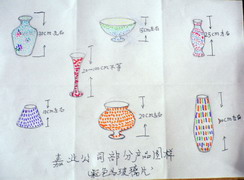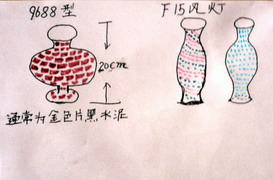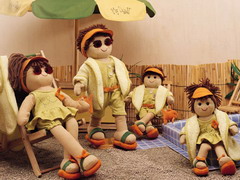Falun Gong Human Rights Newsletter: Where in China Are Your Dolls and Toys Made? (Photos)
The African slave trade, Hitler's concentration camps, and the Soviet gulags, all added together, are not enough to describe the sinister nature of the Chinese communist regime's laogai system - the system of "education and rectification through forced labor."
This evil system is by far the most-employed apparatus in the PRC government's persecution of Falun Gong.
What Falun Gong practitioners have further revealed is the absolute cruelty in the Chinese laogai system that had previously evaded academic description. Hundreds of thousands of Falun Gong practitioners have been incarcerated in labor camps and detention centers since the start of the Chinese government's persecution of Falun Gong. At great risk to their lives, these practitioners continue to send firsthand information on the torture, killing, and slave exploitation of prisoners throughout China. Their tear and blood-stained reports add "texture" and "content" to what we know about the Chinese laogai system, a most cruel system against humanity.
The laogai system is a machine of genocide. The majority of the thousands of deaths of Falun Gong practitioners have occurred in labor camps.
The laogai system is a machine of torture. The guards of the Masanjia Labor Camp, for example, openly shout at Falun Gong practitioners: "This is a living hell!" With the instruction from the central government that, "No measure is too excessive against Falun Gong," the types of tortures used in the labor camps and detention centers are limited only by the imaginations of demonic minds, and the amount of pain inflicted is limited only by the death of the victim.
The laogai system is a machine of corporate fascism. With no concern about the source and availability of slaves, prisoners are driven to the limit, treated as objects from which the maximum amount of labor is extracted, unloaded when dead, or half-dead, and replaced with fresh ones. The living conditions in the laogai system are absolutely horrific, as any improvement in conditions will subtract from profit.
Unfortunately, the laogai system is in part fueled by western businesses and corporations. On paper, they cannot legally import products made by forced labor. In practice, however, there is nothing to compel their Chinese connections to reveal which goods are made by forced labor. In a few cases when the origins of forced labor products were exposed, the western corporations involved were interested only in protecting their own images and did their best to conceal their participation.
In this newsletter, we reveal a few of the products that are made in the Chinese labor camps by Falun Gong practitioners. The courage of Falun Gong practitioners has undisputedly revealed the existence of a large-scale modern slavery system in China. It took the American Civil War to put a moral end to U.S. slavery, WWII to end Hitler's concentration camps, and the Cold War to end the Soviet gulags. No one knows what it will cost humanity to eradicate the laogai system; however, the foreign money flowing into the Chinese labor camps will only drive the price higher.
Toy Rabbits from a Labor Camp
 |  |
| Signboard on the front gate of Beijing Mickey Toys Co., Ltd. | Toy rabbits produced by Beijing Mickey Toys Co., Ltd. for Nestle |
Location: Xin'an Women's Labor Camp in Beijing
These toy rabbits are products of the Beijing Mickey Toys Co., Ltd., but were made at Xin'an Forced Labor Camp in Beijing. In February 2001, nearly 1,000 detained Falun Gong practitioners were forced to make 100,000 toy rabbits, with no pay, for Beijing Mickey Toys Co., Ltd., subcontracted by Nestle. These products were exported to many countries, including the United States, Canada, Australia, Denmark, Brazil, Hungary, Japan, and Southeast Asia.
Products labeled as "Made in China" can be seen in every corner of the world. However, how many people know that many of the gifts they buy for their children and grandchildren are actually made with slave labor?
Tainting the Olympic Spirit Location: Changle Labor Camp, Weifang City, Shandong Province
From March 30 to April 5, 2004, Falun Gong practitioners detained at Changle Labor Camp were forced to plant trees and dig ditches along the highway from Jinan to Qingdao as part of infrastructure improvements underway to prepare for Qingdao's participation in the 2008 Olympics.
Practitioners who were forced to work included those over 60 years old. Due to long-term malnutrition, poor living conditions, and heavy labor, many practitioners became very weak. Police shouted at them to work quickly, telling them that the hard work would help them "transform" (i.e., give up their belief). They were all exhausted from being overworked. Many of them had never done such hard physical labor in their lives.
The Olympic spirit is to embody courage and nobility, calling the Olympic flame a "sacred fire" passed on to humans by the gods. The PRC's communist regime has tainted this spirit by torturing Falun Gong practitioners to do hard labor for the Olympic Games.
How Vessels Are Made
 |  |
| Product sample diagrams | |
Location: Wangcun Forced Labor Camp, Shandong Province
In July 2002, Falun Gong practitioners detained at Wangcun Forced Labor Camp in Shandong Province were forced to do slave labor, producing various glass products for Zibo Jiaye Company. It was said that these products would be exported to the USA, South Korea, and other countries.
First, let's introduce the production process involved in this slave labor.
First, tinted glass is cut into 1-centimeter-square pieces, then glued onto vessels with 1-2 mm between each piece of glass. Next, the vessels are transferred to the grout workshop, and the gaps are filled with grout, leaving only the upper and bottom edges (about 2 mm) bare. The grout is mixed and smeared into the gaps. Then, a layer of dry cement powder is added and wiped with a dry cloth. Sometimes the grout is white and sometimes it is black. Finally the vessel is cleaned with muriatic acid, which emits toxic fumes.
During the production process, the vessel is put on an emplacement (bracket). With one hand holding the glue, and the other hand holding a piece of glass, one must work continuously to paste the glass onto the vessel. The glue contains large quantities of benzene and other harmful chemicals. Some of the glues emit very strong odors that are toxic. Some people have gotten headaches from it, and had symptoms, such as their eyes turning red, nausea, etc. Due to long-term labor under high pressure, one's eyesight deteriorates. After the glue dries, cement will be added. The cement workshop is filled with dust. There is a large quantity of cement dust in the air. The cement dust is inhaled into the lungs, however there are no labor safeguard measures in place to protect the workers.
The manufacturing cost is no more than one Yuan and the sales price is more than five US dollars. The tag price is usually about US$4.99 or US$5.99. Some larger and detailed products will have a tag of US$14.99, etc.
In 2003, the practitioners had to work from 5:00 a.m. until 1:00 a.m. the next morning. They would begin working without even washing up or brushing their teeth. They had only 15-20 minutes for meals. The meals consisted of radish strips pickled in soy sauce and two pieces of steamed bread. In the wintertime, their hands were frozen to the point of becoming swollen and bleeding.
The workload kept increasing. If one could not accomplish the task, he had to work overtime. Many people became mentally disoriented due to exhaustion. The labor camp would not allow anyone to take a break even if one felt unwell; even those who were in their sixties would not be excused. Their fingers have been worn down from the labor. After repeating one action over and over for a very long time, some people became so weary that they developed heart trouble. Some practitioners became ill, and thus could not work. The police decided that this was affecting the company's profits too much. As a result, most of the practitioners had to go through a new round of persecution. Some of them were beaten and some were forced to stay awake until late into the night.
In October 2003, Mr. Zhao Youqiang from Taian (detained from November 2001 to July 15, 2004) would be awakened at 4 a.m. to work. He had the symptoms of a heart attack because of the hard working conditions. Although he was in severe pain, they still forced him to work. He was tortured in this way until his term expired in July 2004. Practitioners had to pay for anything that was broken during the forced labor.
Mr. Yang Shaofan said that the kind of glue the workers had to use is harmful. What he said was reported to policeman Jing Jisheng. In front of everyone, this policeman ferociously berated Mr. Yang and said, "Jiaye Company has been using this kind of glue for several years. You are spreading rumors if you say it is harmful. I will report this to the leaders and extend your term." He threatened other practitioners so that they would be afraid to speak out. Each day, they forced the practitioners to glue 5,000, 6,000, or even 7,000 pieces.
Shanghai's Toys Location: Shanghai Women's Forced Labor Camp, Shanghai City
 | |
| Ms. Li Ying |
All of these pictures were downloaded from www.mydoll.it. Dolls exactly like those in the pictures were made, in part, in Division Three of the Shanghai Women's Forced Labor Camp between June 2002 and May 2003. Some were packaged and shipped directly to Italy, and others were sent to other locations for further processing or assembly.
Dolls were laid out on the ground after they arrived. Some were moldy from the summer humidity. Detainees would install clothes on them, so the buyers could not see how filthy the dolls really were underneath.
There were time deadlines for the products that were about to be exported. Labor camp detainees, including Falun Gong practitioners, were forced to work from at least 7:00 a.m. to 9:00 p.m. Most people had to work until around 11:00 p.m.
 | |
| Picture 1 |
The pants and the flower pattern on the right pant-leg of the toy bear sitting on the chair (Picture 2) were also partially made in the labor camp. The flower on the doll's cap was also made in the labor camp.
 |  |
| Picture 2 | Picture 3 |
The packaging process was as follows: we put the pants on the doll. We positioned the pants so the doll's legs were not exposed; we put shoes with white socks on the doll's feet, folded the socks twice down and put the dress on the doll, affixed the head flower on the doll and wrapped it around its head two times. We cut the thread ends and combed the hair. We put the hat on the doll and put it in a white cloth sack, put drying agent under the doll's buttocks, then wrapped it in a transparent plastic bag, folded the paper box and put the fully packaged doll in the paper box. Each person was assigned to package 120 dolls per day.
 | |
| Picture 4 |
In picture 4, the flower patterns on the doll dresses in this picture were all embroidered at the labor camp. One line was embroidered smoothly on the collar and the bottom of the apron, with a space of 0.5 centimeters between stitches. The packaging process and amount of work are the same as in picture 3.
In pictures 5 and 6, the butterflies and their wake [the trails by which the butterfly flew] on the dolls' clothes were done at the labor camp. It was required that the line along which the butterflies were stapled be invisible and the butterflies' traces must be even and smooth, with no rigid corner or lines.
 |  |
| Picture 5 | Picture 6 |
http://www.falunhr.org/newsletter/Issue16.html